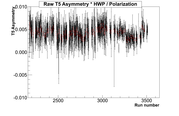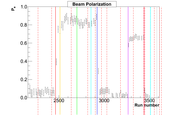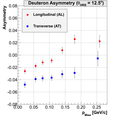3He(e,e'd) Analysis
Moller Polarization Measurements
Here are the Moller measurements done during e05-102 experiment:
01.) 
Analysis done with T5 scalers:
I have considered the advice from last week, and try to reconstruct
the beam polarization from our raw asymmetry measurements. First
I considered T5 asymmetry, since it is always non zero. I corrected
the asymmetry for the HWP position and target orientation. To lower
the error bars I joined measured points in groups of ten.
In the end, when I calculate the polarization from these measurements,
I realize, that the error bars are so large, that no conclusion
can be drawn from them.
02.)  03.)
03.)  04.)
04.)  05.)
05.) 
06.)  07.)
07.) 
Analysis done with T3 scalers:
Here I did the same thing, but with T3 raw asymmetry. The
statistics here is much better. However, the error bars
on the polarization are still to large. In addition,
raw T3 asymmetry has non-zero values only when target
is polarized in transverse direction. For the longitudinal case,
T1 should be used, which has exactly opposite behavior.
08.)  09.)
09.)  10.)
10.)  11.)
11.) 
12.)  13.)
13.) 
I believe that the only thing that I could do, is to observe
the raw asymmetry plot, and somehow try to determine, if there
is some "trend" in the observed results. That would indicate
a change in the polarization of beam and target. This is work in progress.
New Proton Asymmetry Results
I have new results for proton asymmetries:
14.)  15.)
15.) 
"2BBU" Asymmetry:
I have new results for proton asymmetries, when I do a cut on low missing energy:
16.)  17.)
17.) 
Proton Polarization
Calculation of the Proton polarization from the 2bbu:
18.) 
New Deuteron Asymmetry Results
I have new results for deuteron asymmetries:
19.)  20.)
20.) 
Comparison with the calculations:
I have compared (just for a taste) the measured deuteron asymmetry at 14deg with the
theoretical calculations from Golak, that were made for HRSL at 15deg
and BB at 71deg:
21.)  22.)
22.) 
To be able to compare theory with my measurements, I had to average
theoretical results over the phi_{dq}. When doing so, I considered, that
all angles are not equally represented. Therfore, I have weighted asymmetry of each
phi_{dq} bin with the number of the events in that particular bin.
23.) 
24.) 
Last modified: 01/11/12

 03.)
03.)  04.)
04.)  05.)
05.) 
 07.)
07.) 
 09.)
09.)  10.)
10.)  11.)
11.) 
 13.)
13.) 
 15.)
15.) 
 17.)
17.) 

 20.)
20.) 
 22.)
22.) 

